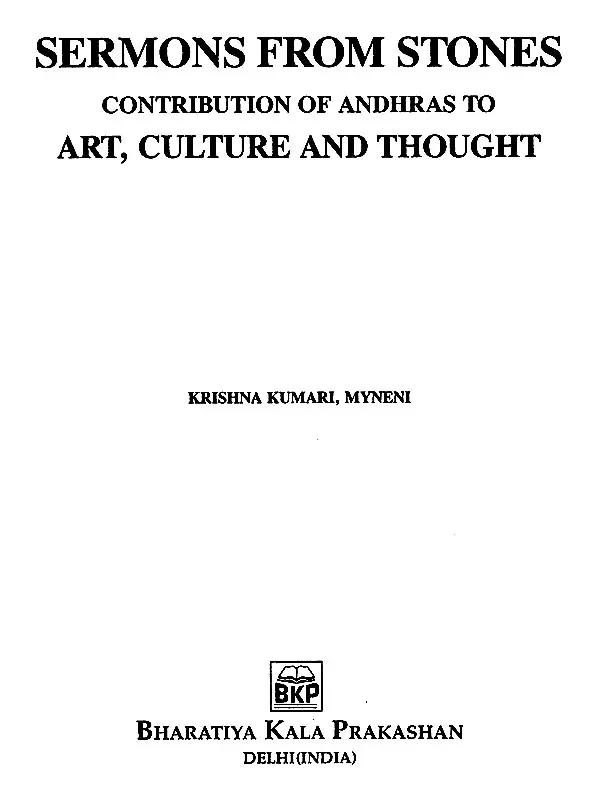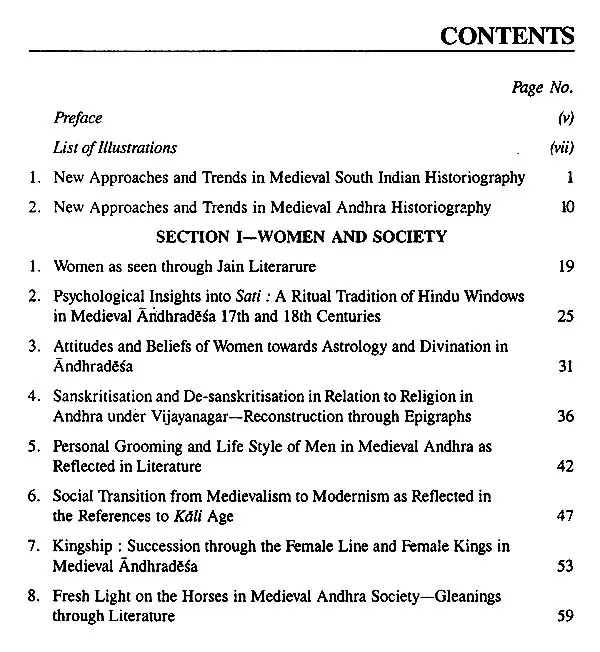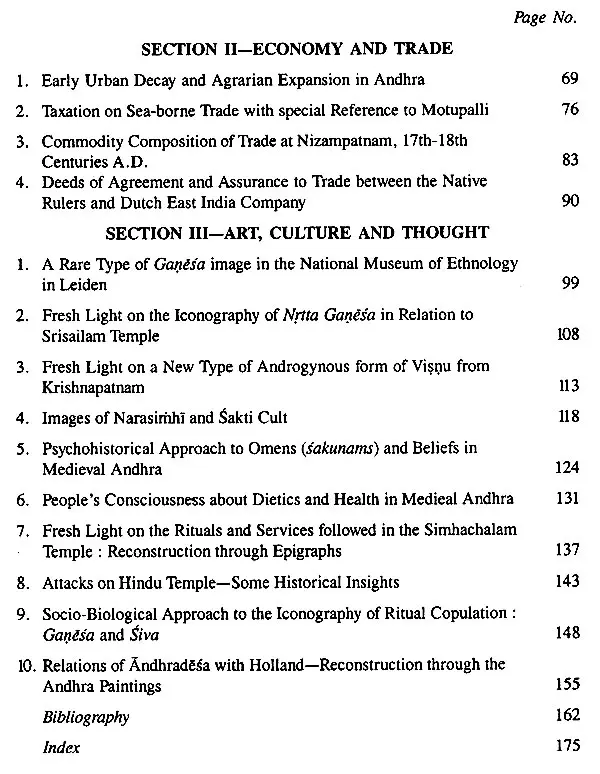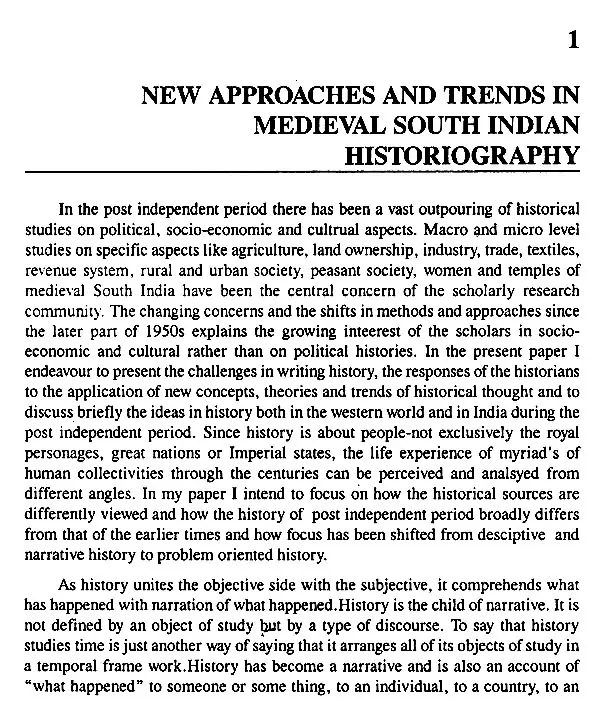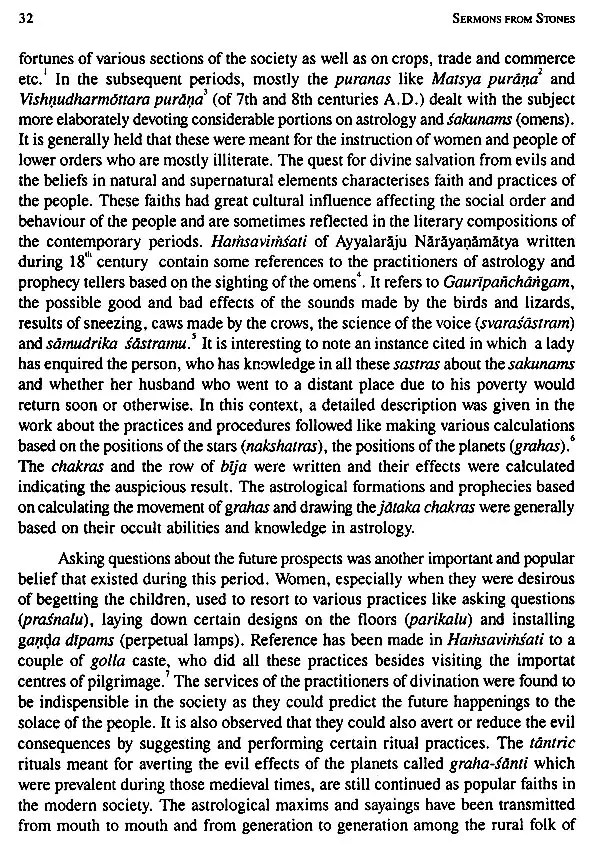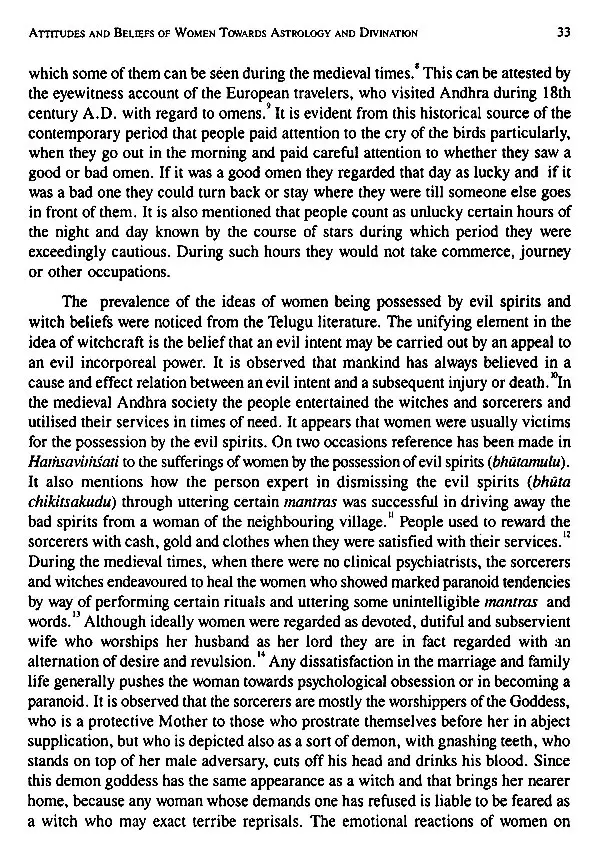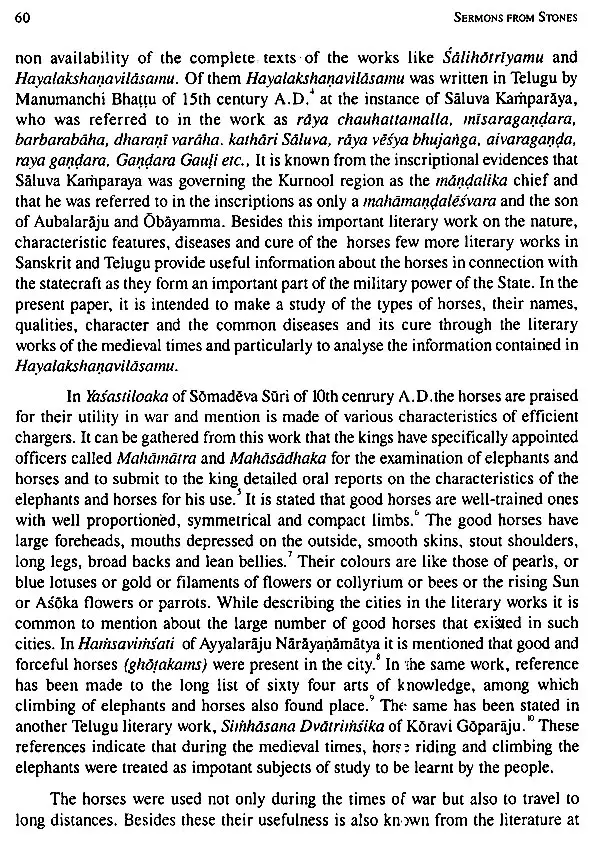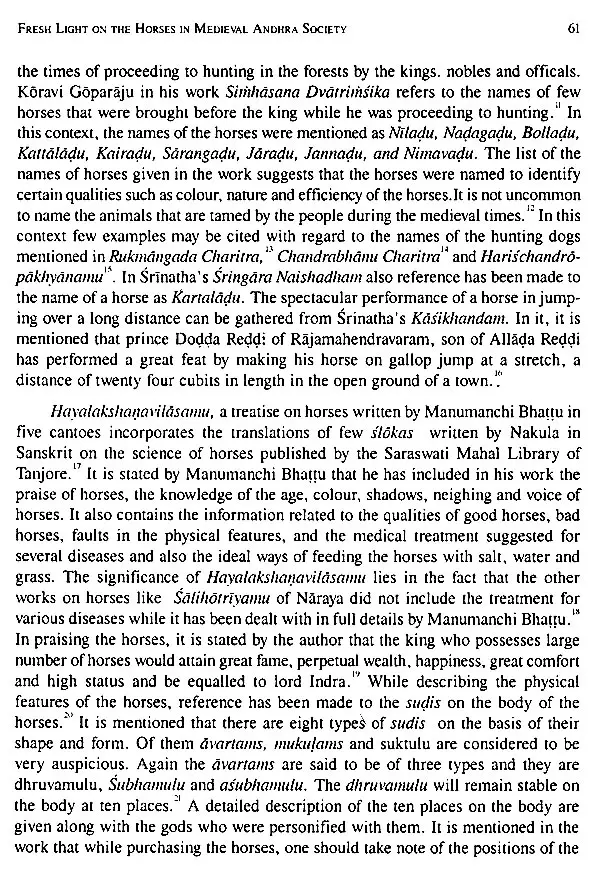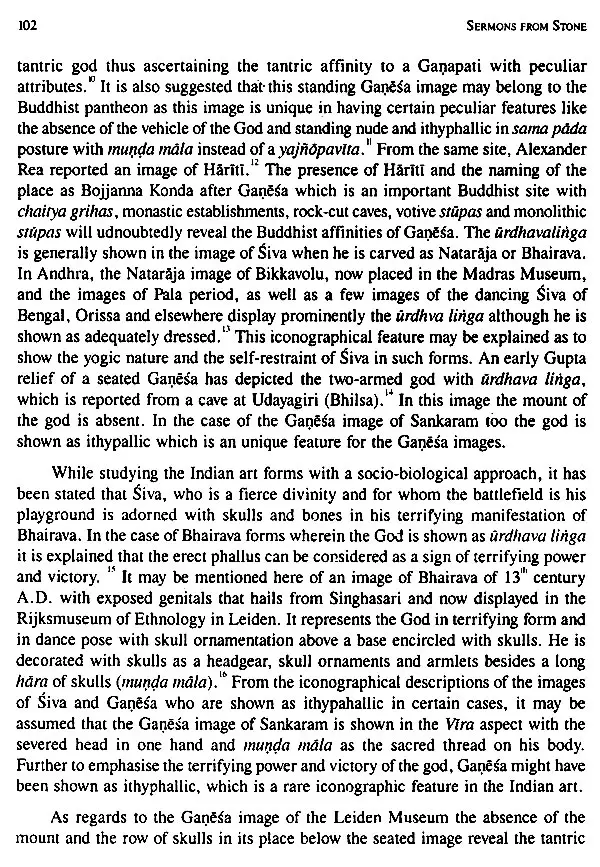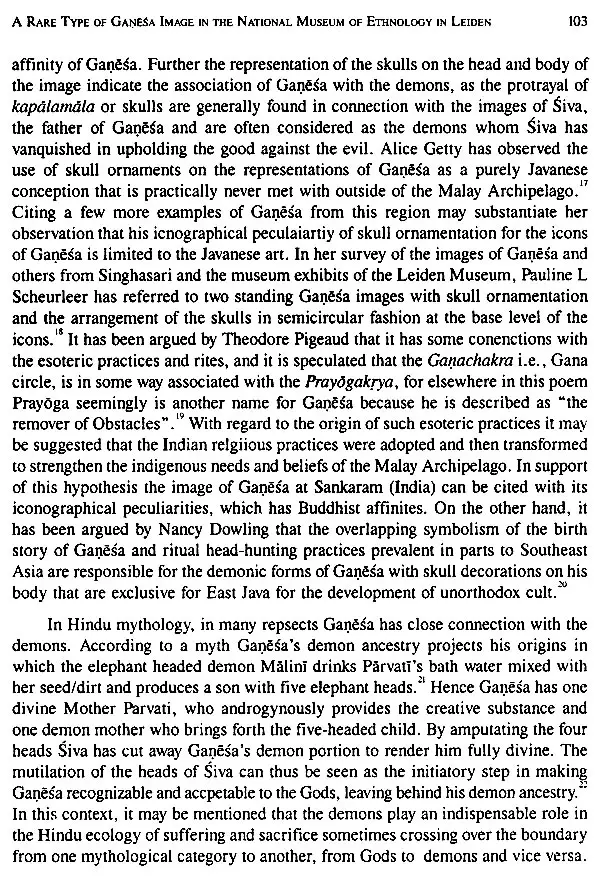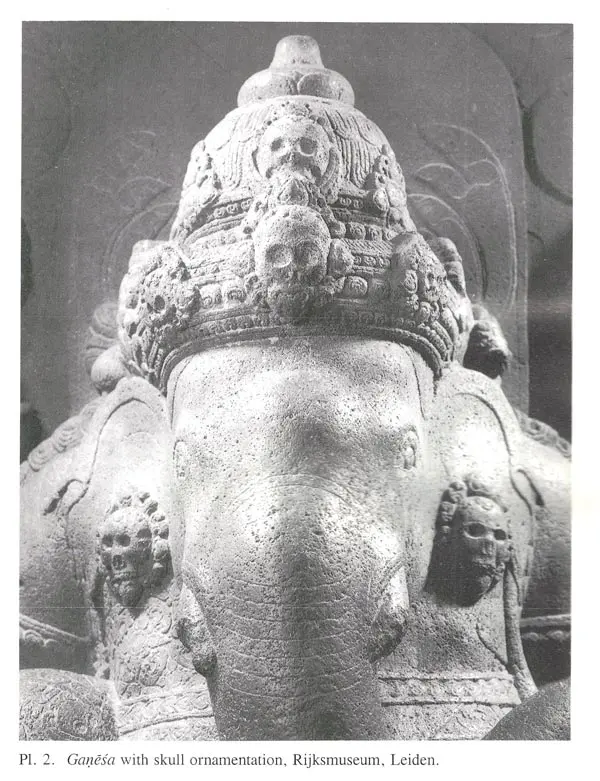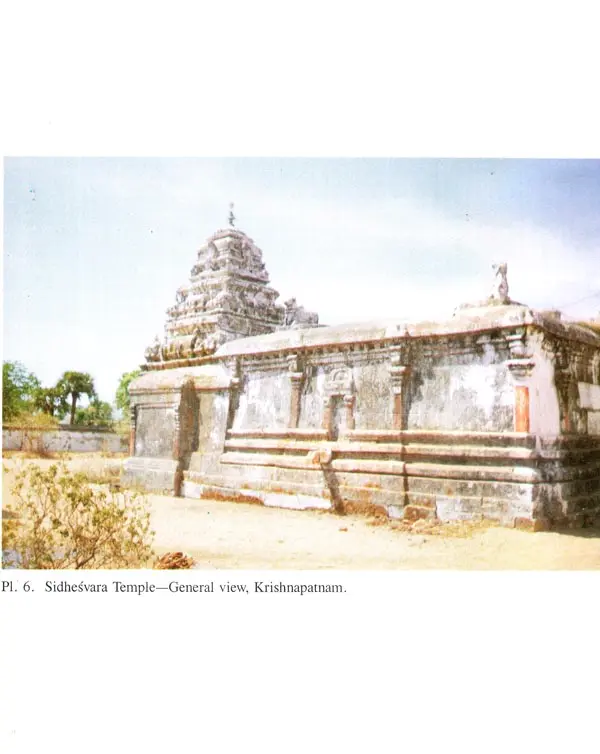
Sermons from Stones Contribution of Andhras to Art, Culture and Thought
Book Specification
| Item Code: | UAO077 |
| Author: | KRISHNA KUMARI |
| Publisher: | Bharatiya Kala Prakashan |
| Language: | English |
| Edition: | 2002 |
| ISBN: | 8186050892 |
| Pages: | 203 (Throughout Color and B/w Illustrations) |
| Cover: | HARDCOVER |
| Other Details | 10.00 X 7.50 inch |
| Weight | 650 gm |
Book Description
This book speaks of the contribution of Andhras to the development of its culture covering different aspects of medieval Andhra history. The three sections in this book em bodies the subjects on Women and Society: Economy and Trade: Art and Culture. The 20 essays included in this book provide glimpses of the contribution of Andhras to the development of religious ideas, customs. beliefs and practices which are subjected to critical analysis with the tools of new metho dologies like psycho-historical approach and socio-biological approach besides re-examin ing the historical data with a new and fresh outlook. This book addresses the questions of how the mind works in relation to the estiblishment of certain beliefs and religious practices, gender issues like how women were portrayed in the Jain literature and women's attitudes and beliefs. The book gives vivid description about the rare and unique images of Ganesa, Siva and Vishnu and the religious ideology that lies behind the carving of such icons and the spread of the ideas and art traditions to South-east Asian countries. Un like many previous works, it considers the socio-economic background of pre-colonial Andhra as mainly responsible for the emer gence of Andhradeśa as a distinct, regional and cultural entity with efflorescence in art. and letters.
The book based on original sources such as inscriptions, art forms and contemporary literature is codified to suit the research scholars and students with an admixture of research articles and essays relating to the medieval Andhra society, economy and culture which reflects the regional specificity in the development of the art and culture that forms the backbone of Indian culture today.
Dr. M. Krishna Kumari took her M.A.. Ph.D. and D.Litt., degrees in Ancient History and Archaeology from the Andhra University in 1973, 1978 and 1999 respec tively. She is the recipient of UGC Young Scientists Award in Humanities and Social Sciences (Career Award) for the year 1984 85. She has been honoured with "Best Re searcher Awar" by the Andhra University in 1992 and Best Teacher Awar" by the Andhra Pradesh State Government in 2001. She has been on the teaching staff in the department of History and Archaeology of Andhra Uni versity, Vishakhapatnam since 1974 and is now Professor in the Department. She has served the University in various capacities as the Head of the Department, Chairperson, P.G. Board of Studies and is presently the member of the Executive Council of the Andhra University. She is a prolific writer and a good researcher and has published seven books related to the history and culture of Andhras besides many research papers in various academic and professional jour nals. She specialises in South Indian epigra phy, art-history, archaeology. Medieval South Indian history and Andhra history. She is a visiting Professor to Armstrong Atlantic State University (US). She has completed four reaserch projects funded by UGC and ICHR and actively participated in several national and international conferences and delivered several keynote addresses and lectures as resource person at seminars and workshops.
This book is an effort to illuninate the various aspects of Andhra culture through different methodogical approaches to unravel the beliefs, ideas and traditions of Andhras and the changing historical processes of the bygone ages especially of the medieval times. Based on the epigraphical, sculptural and literary data of the contemporary period of study, it encounters with Andhradeśa to present a coherent picture of the socio-cultural phenomena and thought through the psychonalytic approach. It tries to project the best examples of the psychoanalytic engagement of the people, particularly in the field of beliefs and ritual practices. The empirical study of the writings found on the walls of the temples, other monuments and the copper plates bring to light interesting details of the social, economic and ritualistic practices which would otherwise be unknown and thus contribute to the historical knowledge. The study attempts to put in historical perspective the intricate details of the social, cultural and religious life of the people of different strata with the help of all available archaeological and historical evedences. Re-looking and reconsideration of the temple sculptures and icons from a fresh perspective has been attempted with the view to understand its religious meaning and symbolism along with the changing religious traditions and ritual practices. The work not only demonstrates the different aspects of society, economy and culture of the Andhras of the medieval times but also certain less known and commonly ignored aspects of life and culture of the people. Besides it considers and questions some assumptions and theories on the basis of thorough and critical examination of the available historical sources to present objective views on.various problems. The book is a collection of twenty research papers on various aspects of women, society, economy and culture of the Andhras of medieval times. I do not venture to make any tall claims about its completeness on the subject, as I know pretty well to what extent they are incomplete and how the outline of some of them has been only sketchy. However, the views presented here through these studies are altogether new, based on new methodological approaches. Further, these are based on epigraphs from which one can expect more authentic and objective information. The contemporary Telugu and Sanskrit literature which generally reflects the socio-religious and economic changes in the society are also consulted wherever necessary. Likewise, fresh ideas and new thinking in art historical studies are resulted in the radical re-appraisal of the icons and sculptures found in the temples and museums. Unlike many previous works, it considers the socio-economic background of pre-colonial Andhra as mainly responsible for the emergence of Andhradeśa as a distinct, regional and cultural entity with its efflorescence in art and leters.
The book is divided into three sections covering the aspects of women and society in section 1, preceded by a brief survey of the recent trends in the historiography of South India in general and Andhra in particular. The outlook of the people in the society about women, their nature and character as revealed through the Jain literary works written by Somadeva Suri is presented. The ghastly ritual practice of burning the widows on the funeral pyre of the dead husband and the psychological implications behind the practice of sati are highted on the basis of the contemporary foreign accounts and other historical sources. The beliefs of women in regard to certain superstitions, astrology and divination are explained with the help of the historical literature. It also projects how the people, irrespective of caste and class have accepted these views and ideas as the social norms of the day and how they resorted to observe uniformly certain ritual practices by breaking the socio-economic barriers among them. The subsuming of several autochchotonous and native or tribal communities into the Hindu fold had ultimately resulted in the proliferation of several castes and sub-castes. This has necessitated the incorporation of several local and village deities into the Sanskritic tradition of Hindu faith. As a result, several village deities have been elevated to the ritualistic status of traditional Hindu deities and thereby they found place in the temple complexes. Focus has been laid on the life style of men and their interests in personal grooming during the medieval times. Political power and authority which were rarely exercised by women such as Rudramadevi and Ganapamadevi as the heads of the state are examined to heghlight the underlying reasons behind their selection and legitimisation as female kings. The role played by horses, their nature, character and diseases are discussed at length based on contemporary literature of medieval times.
